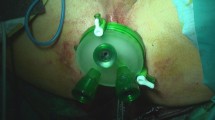Abstract
Background
Recently, the efficiency of transanal minimally invasive surgery (TAMIS) for rectal cancer has been demonstrated (Velthuis et al. in Surg Endosc 28:3494–3499, 2014; Fernandez-Hevia in Ann Surg 261:221–227, 2015; Atallah et al. in Tech Coloproctol 18:473–480, 2014). We present our procedure of TAMIS for extralevator abdominoperineal excision (ELAPE) (Holm et al. in Br J Surg 94:232–238, 2007).
Methods
The patient had a rectal cancer located 4 cm from the anal verge with suspected invasion of the levator ani (cT4bN0M0). A skin incision was made around the tightly closed anus, and a GelPOINT device was placed. The fat tissue of the ischioanal fossa was divided until the levator ani muscle was widely exposed. Anterior dissection was performed just behind the transverse perineal muscle, and the arms of the puborectalis sling were identified at 1 and 11 o’clock. The levator muscle was divided from the posterior to bilateral sides, and dissection was entered into the mesorectal plane. Posterior dissection was performed until the sacral promontory was reached. Bilateral pelvic splanchnic nerves were identified at the 5 and 7 o’clock positions, and special care was taken to preserve them. At the anterior side, the arms of the puborectalis sling and perineal body were divided. Special care should be taken to avoid inadvertent injury to the anterior tissues (urethra or prostate) because the dissection tends to go toward the anterior-lateral side of the prostate in this approach. Once the dissection plane behind the prostate was established, it was easy to dissect the mesorectum circumferentially while preserving the pelvic autonomic nerves. Vascular division, mobilization of left colon and stoma creation were performed laparoscopically.
Results
This approach provides better exposure of the surgical field, especially at the anterior side, compared with the conventional perineal approach of ELAPE. Since January 2014, we have performed seven cases using this procedure. There was no conversion to the conventional approach, and no major complication was encountered.
Conclusion
TAMIS is a promising approach for the perineal phase of ELAPE.
Similar content being viewed by others
References
Velthuis S, Nieuwenhuis DH, Ruijter TE, Cuesta MA, Bonjer HJ, Sietses C (2014) Transanal versus traditional laparoscopic total mesorectal excision for rectal carcinoma. Surg Endosc 28:3494–3499
Fernandez-Hevia M, Delgado S, Castells A et al (2015) Transanal total mesorectal excision in rectal cancer: short-term outcomes in comparison with laparoscopic surgery. Ann Surg 261:221–227
Atallah S, Martin-Perez B, Albert M et al (2014) Transanal minimally invasive surgery for total mesorectal excision (TAMIS-TME): results and experience with the first 20 patients undergoing curative-intent rectal cancer surgery at a single institution. Tech Coloproctol 18:473–480
Holm T, Ljung A, Haggmark T, Jurell G, Lagergren J (2007) Extended abdominoperineal resection with gluteus maximus flap reconstruction of the pelvic floor for rectal cancer. Br J Surg 94:232–238
Author information
Authors and Affiliations
Corresponding author
Ethics declarations
Disclosure
Suguru Hasegawa, Tomoaki Okada, Koya Hida, Kenji Kawada and Yoshiharu Sakai declare no conflict of interest.
Electronic supplementary material
Below is the link to the electronic supplementary material.
Supplementary material 1 (MP4 325548 kb)
Rights and permissions
About this article
Cite this article
Hasegawa, S., Okada, T., Hida, K. et al. Transperineal minimally invasive approach for extralevator abdominoperineal excision. Surg Endosc 30, 4620–4621 (2016). https://doi.org/10.1007/s00464-015-4736-2
Received:
Accepted:
Published:
Issue Date:
DOI: https://doi.org/10.1007/s00464-015-4736-2




